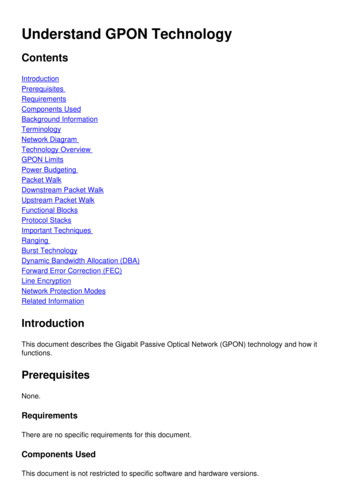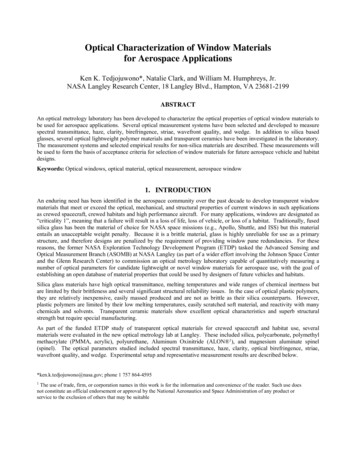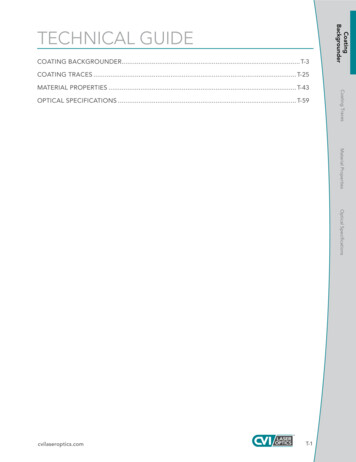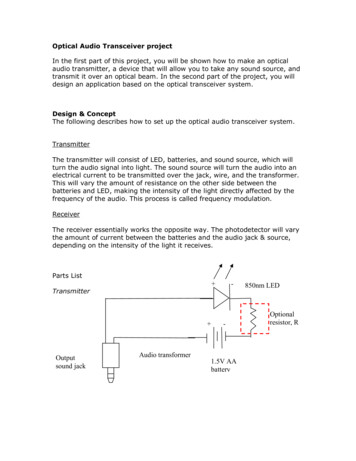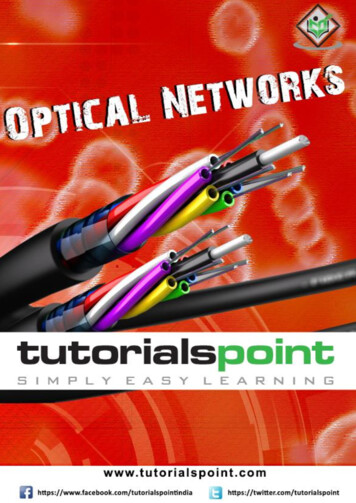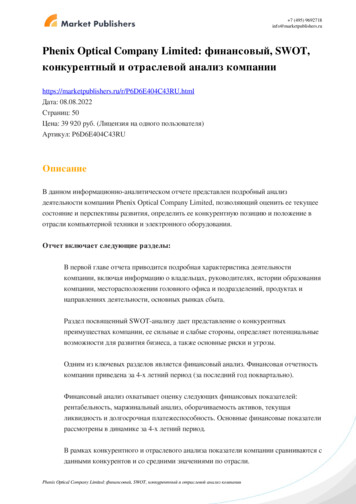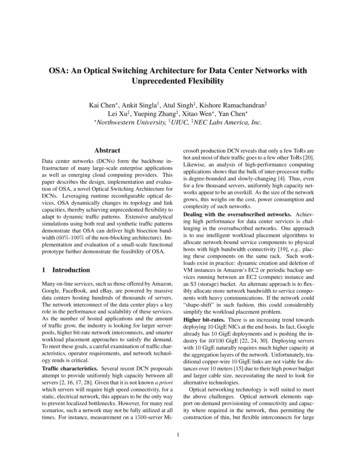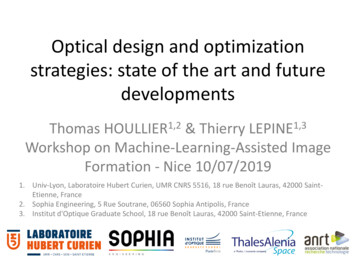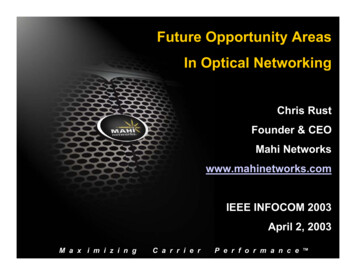
Transcription
Future Opportunity AreasIn Optical NetworkingChris RustFounder & CEOhMahi Networkswww.mahinetworks.comIEEE INFOCOM 2003April 2, 2003M a x i m i z i n gC a r r i e rP e r f o r m a n c eTM
Agenda Drivers Of The Bubble and Explanation of What ChangedThemes in Network Transformation and Catalysts for InnovationOverview of Current NetworkLong-Term Future NetworkA Close Look At An ILEC Central Office – Case Study inOpportunity– Present Method of Operation– Role of Metro Core Aggregation Systems (MCAS) in Next Gen CO– Economic and Operational Benefits of MCAS Deployment Closing Thoughts 2003 Mahi Networks, Inc.
The Virtuous Cycle of 1997-2000Internet Boom Telecom Act of 1996 HypergrowthabundantcapitalILECs, IXCsmerge for scaleemerging carriers(CLECS, ISPS)pro-competitiveregulationStrong InternetSub GrowthhyperhypercompetitioncompetitionBW & serviceDemand - Carrier ProfitsapplicationsexplosionNeed to broaden,bundle servicesConverged Networkvoice/data/video/mobilityoperational efficienciescompetitive advantagelowerlatency 2003 Mahi Networks, Inc.changing traffic mixvoice @ 7% per yeardata @ 120% per yearSpike in infrastructurecapital expendituresdisruptivetechnologies(i.e. DWDM)cheap, abundantbandwidth
Big Themes In Network EvolutionSurvivorsSurvivors OfOf TheThe ValleyValley OfOf DeathDeathTheme Electrical To Optical Circuit To Packet Overlays to Shared Multi-Service Narrowband To Broadband Static Pt-Pt to Agile/Dynamic Transport / Switching Integration Manual To Automated Rings To Mesh (in IOF, LH) “Embedded Base Optimization”– Networks Will Be Added To, NotReplaced, Due To EconomicRealitiesDrivers – Largely Non-Technical Basic Carrier Viability– Capex Reductions– Dramatic Opex Reduction “Triple Play” V/D/V BundlesChanging Traffic Patterns–––– Larger pipesMore dataDecreasing Revenue/bitMore Churn“All Distance Telecom”Next Gen ContentContinued Innovation And Investment Needed At OpticalComponent, Systems, and Software Layers 2003 Mahi Networks, Inc.
Current Network – Parallel TDM and DataSS7 & AIN NetworkSTPSCPMTSO for WLessSTPLEGACYDIAL ACCESSTo long distancevoice networkATU-RClass 4 SwitchClass 5 SwitchxDSLDSLAMCoreATM NetworkRASSMSNGDLCONUBBAND GWAYFR NetworkFIREWALLCONTENT CACHELOAD BALANCERRouted IPNetworkVOICE DATA LEASED LINEWEB SERVERAPP SERVERIP/ MANAGED VPNDBASE SERVERSANSTORAGETDM Transport NetworkSONET ADM, DCS - MSPP 2003 Mahi Networks, Inc.PBX and LAN
Future Network – Rich in Optics And PacketsVoP Softswitch Call Control Complex SIGNALINGINTERWORKINGUNITSS7 & AIN NetworkSTPSCPSTPClass 5 SwitchLEGACYDIAL ACCESSVoDSL MuxxTU-RxDSLSMSCore NetworkIP/MPLS over DWDM, MCASVoP CARRIERCONVERGENCESWITCHPacket-based Multi-line voic&dataover copper, wireless, and coaxMSPPIntelligent Optical EdgeFIREWALLONUCONTENT CACHELOAD BALANCERATM NetworkSTREAMING SERVERWEB SERVERFR NetworkIPMANAGED VPNAPP SERVERDBASE SERVERSANDynamic Optical TransportMCAS: ADM BBDCS, ROADMΛ conversionCENTRAL STORAGE 2003 Mahi Networks, Inc.LOCAL CACHEDISTRIBUTEDSTORAGE
Zooming In - Today’s Metro/IOF COBased on Stacked ADM/MSPPs and DS-3 Interconnections DS3 is the most commonCO currency today, andthe top selling MSPP card Craft-intensivearchitecture based oncoax and DSX panels Inefficient manual crossconnect process Multiple points of failure High space and powerrequirements High Capex and Opexpenalties 2003 Mahi Networks, Inc.
Tomorrow’s CO Using Current ApproachHigh-Cost Equipment Stretches CO Limits Continue to spend on nonoptimized networkelements Inefficient manual crossconnect process Increased points of failure Greater space and powerconsumptionNew Circuit Growth 2003 Mahi Networks, Inc. Result longer spans morerepeaters facility exhaust fromfloorspace, riser,plenum consumption Opex grows w time
Mi7 Optical Node Interconnection (ONX)Eliminates DS-3 Plumbing and Speeds Provisioning Elimination of networkelements and cabling Enables softwareconfigurable crossconnects Fewer points of failureimproves reliability Major capex and opexsavings with simplerarchitecture Requirements DCS for LEC network LEC OSS; OSMINE Path to OXC integrationfor express channelsSRAONX ONXMET 2003 Mahi Networks, Inc.ATN
Mi7 SONET Ring Aggregation (SRA)Reduces SONET Equipment and Improves Management Eliminates SONET/SDHADM/MSPP ‘Stacking’ Eliminates optical andelectrical inter-connection Further decreases spaceand power Relieves plenum and risercongestion Requirements High OC3/OC12 fan out Remoteable DS3 access IP and OSI DCC interop Low installed 1st cost SR/IR/LR laser supportSRASRA MET 2003 Mahi Networks, Inc.ONXATN
Mi7 Metro Ethernet Transport (MET)Re-Employs SONET Facilities For Carrier-Class Ethernet End service-specificoverlay networks via L1transport/L2 switchingintegration Reduce costs byeliminating L2 switch layer Requirements: L2 Stat-Mux in MCASfor oversubscription tolower transport costs VLAN processing GbE - SONETmediation gateway Scalable L2processingSRAONXMET MET 2003 Mahi Networks, Inc.ATN
Mi7 Automated Transport Network (ATN)GMPLS Mesh Protection and Automated ProvisioningA TO Z PROVISIONING COMMAND Requires “intelligent”MCAS with full IPcontrol plane STS1 Grooming andM:N Mesh Networking Multi-Vendor NetworkTopology Discovery Similar to SS7 Effecton Voice NetworkGMPLSMesh NetworkSRAONXMET 2003 Mahi Networks, Inc.ATN ATN
The Mi7 Metro Core Aggregation SystemPlatform OverviewMi7 System SpecificationsMi7320 GbpsMulti-SvcMCAS Dx7 ElectricalTributaryExpansionShelf OSMINE SONET: Synchronous Optical NetworkGMPLS: Generalized Multi-protocol Label SwitchingVSR: Very Short Reach lasers; LR Long Reach lasersSONET/SDH add/drop multiplexerwith integrated cross-connect, L2switch & GMPLS control planeDS3—OC-192 interfaces (VSR-LR)512 OC3/12, 128 OC48, 256 GbETarget Applications: Optical Node Interconnection SONET/SDH Ring Aggregation Metro Ethernet Transport Automated TransportNetworkingMulti-vendor interop: replace COADMs and re-deploy them to edge Low installed first cost & pay-asyou-grow price flexibility 2003 Mahi Networks, Inc.
RBOC CO Economics: MSPP DSX PMO vs MCAS FMOCapEx and OpEx Results For 20 OC48/Year With Net OASys Power SavingsPercentage %40%30%20%10%0%12345678910111122345Time (Quarters)6789101112Time (Quarters)Bay RequirementsOpex Savings(includes Space, Power, Service 3456789101112123456789Time (Quarters)Time (Quarters)Mahi Networks Net OASys 2003 Mahi Networks, Inc.10 11 12
Summary Industry Took An Abrupt Pause After 3 Years Of Irrational Exuberance,But Future Of Optical Networking Remains VibrantTraffic Growth Drivers Have Slowed, But Bright Spots Remain– Total US High Speed Data Subs Grew 45% to 18.3m and 23% of Homes in 02with Cable at 11.5m, DSL at 6.5m (Lehman Brothers 3-14-03) Bandwidth-Intensive Emerging Services Such as Personal VideoRecorder, Pay-Per-View, HDTV, High Quality Audio are HappeningMajor Opportunities Remain At All Levels Of Optical Foodchain– Systems: MCAS, DWDM/ROADM, Ethernet Metro Access, – Components: Metro EDFA, Tunable everything, next gen packaging– Software: GMPLS, Wavelength Services, Key Growth Drivers For Next Optical Wave Are Economic, Not Technical– E.g. Business Value of Multi-service MCAS With Intelligent Control Plane IsRedefining How Local Exchange Networks Are Built, Operated 2003 Mahi Networks, Inc.
RBOC CO Economics: MSPP DSX PMO vsRBOC CO Economics: MSPP DSX PMO vs MCAS FMOMCAS FMO. CapEx and OpEx Results For 20 OC48/Year With Net OASys Percentage Savings 0% 10% 20% 30% 40% 50% 60% 70% 80% 90% 123456789101112 Time (Quarters) Power Savings 0% 10% 20% 30% 40% 50% 60% 70% 80% 90% 123456789101112 Time (Quarters) Opex Savings (includes .

